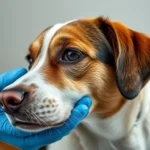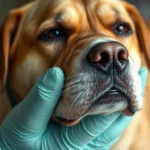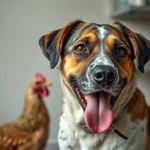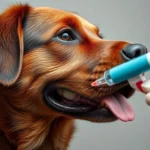
Canine acne is a condition that often raises many questions among dog owners. Understanding this skin issue is crucial for effective management and treatment. Pet owners frequently express concerns about symptoms, treatment options, and prevention strategies when seeking veterinary advice.
Understanding Canine Acne
What is Canine Acne?
Canine acne is a dermatological condition characterized by the formation of pimples or pustules on a dog’s skin, particularly on the chin, lips, and face. It is primarily seen in adolescent dogs, but it can occur in adults as well. Unlike human acne, which is primarily driven by hormonal changes and lifestyle factors, canine acne has different underlying causes and manifestations.
Causes of Canine Acne
Understanding the causes of canine acne can help pet owners anticipate and manage the condition effectively. Here are some key contributors:
-
Hormonal Changes: Just like humans, dogs experience hormonal fluctuations, especially during puberty. These changes can lead to increased oil production and clogged pores.
-
Allergies: Both food and environmental allergies can manifest as skin issues, including acne. Identifying and eliminating allergens from your dog’s diet or environment can be beneficial.
-
Poor Grooming Habits: Inadequate grooming can lead to the accumulation of dirt, oils, and bacteria on the skin, contributing to acne formation.
-
Bacterial Infections: When hair follicles become clogged, it can result in bacterial overgrowth, leading to inflammation and acne.
-
Genetics and Breed Predisposition: Some breeds, such as boxers and bulldogs, are more prone to developing acne due to their skin structure and genetics.
Symptoms of Canine Acne
Recognizing the symptoms of canine acne is essential for early intervention. Common signs include:
-
Pimples or Pustules: These are often red, inflamed bumps that may contain pus.
-
Swelling: The affected areas may appear swollen or irritated.
-
Crusty or Scabbed Skin: In severe cases, dogs may develop scabs as a result of scratching or secondary infections.
-
Itching or Discomfort: Dogs may show signs of discomfort, such as scratching or rubbing their face.
The severity of canine acne can vary from mild to severe. It generally affects areas such as the chin, lips, and muzzle.
Diagnosing Canine Acne
Veterinary Examination
When you visit the vet with concerns about your dog’s skin, you can expect a thorough examination. The veterinarian will assess the affected areas and ask about your dog’s medical history, grooming habits, and any recent changes in diet or environment. A comprehensive examination is crucial for diagnosing canine acne accurately.
Diagnostic Tests
To confirm the diagnosis and rule out other skin conditions, your vet may recommend several diagnostic tests:
-
Skin Scrapings: This test helps identify any parasites or fungal infections that may be contributing to the symptoms.
-
Allergy Testing: If allergies are suspected, your vet may suggest allergy testing to identify specific triggers.
-
Bacterial Cultures: In cases of persistent or severe acne, bacterial cultures can help identify any underlying infections that need to be addressed.
Treatment Options
Home Care and Management
Many cases of canine acne can be managed at home with proper care. Here are some effective strategies:
-
Cleaning Routines: Regularly clean the affected areas with a mild antiseptic solution to reduce bacteria and promote healing.
-
Best Grooming Practices: Ensure your dog is groomed regularly to remove dirt and oils. Use non-irritating grooming tools to minimize irritation.
-
Using Non-Irritating Products: Choose shampoos and topical treatments that are specifically designed for dogs and are free from harsh chemicals.
Veterinary Treatments
If home care isn’t enough to control the condition, your veterinarian may recommend more intensive treatments:
-
Topical Medications: Your vet may prescribe medicated shampoos or creams that help reduce inflammation and bacteria on the skin.
-
Oral Medications: In cases of severe acne, oral antibiotics or corticosteroids may be necessary to manage inflammation and infection.
-
Surgical Options: For cystic acne, draining the cysts or lesions may be required to relieve discomfort and prevent further complications.
Alternative Treatments
Some pet owners explore alternative treatments for canine acne. While not all natural remedies are effective, some may provide relief:
-
Natural Remedies: Ingredients like aloe vera or coconut oil can soothe irritated skin, but consult your vet before trying these.
-
Role of Diet and Nutrition: A balanced diet rich in omega-3 fatty acids can promote healthy skin. Nutritional supplements may also help improve overall skin health.
Prevention Strategies
Regular Grooming
Maintaining good hygiene is key to preventing canine acne. Regular grooming helps remove dirt, oils, and dead hair from your dog’s skin.
- Recommended Grooming Tools: Use soft brushes and combs that won’t irritate your dog’s skin. Regular baths with appropriate shampoos can also aid in keeping the skin clean.
Diet Adjustments
What your dog eats can significantly impact their skin health.
-
Foods That Help Reduce Acne: Incorporating high-quality proteins and omega fatty acids can improve skin condition. Avoid fillers and artificial additives that may trigger allergies.
-
Supplements: Omega-3 and omega-6 fatty acids are known for their anti-inflammatory properties and may help manage skin issues.
Environmental Considerations
To reduce the risk of acne flare-ups, consider the following environmental factors:
-
Reducing Allergens: Regularly clean your dog’s bedding and living areas to eliminate dust, pollen, and other allergens.
-
Managing Stress Levels: Stress can exacerbate skin conditions, so ensure your dog has a stable and calm environment. Engaging in regular playtime and exercise can also help reduce stress.
When to Seek Veterinary Help
Signs That Require Immediate Attention
It’s essential to recognize when canine acne might require professional intervention. Look for:
-
Severe Swelling or Pain: If your dog shows signs of significant discomfort, it’s time to see the vet.
-
Signs of Infection: Pus, fever, or an unpleasant odor can indicate a secondary infection that needs immediate attention.
-
Persistent or Worsening Symptoms: If the acne does not improve with home care or worsens, consult your veterinarian for further evaluation.
Follow-Up Care
Even after initial treatment, follow-up visits are crucial. They allow your vet to monitor your dog’s progress and adjust treatment plans as necessary. Regular check-ups can help ensure that any underlying issues are addressed promptly.
Frequently Asked Questions (FAQs)
Can canine acne spread to other pets?
No, canine acne is not contagious and cannot be spread to other dogs or pets. It is primarily a reaction to individual factors such as hormones, allergies, or grooming habits.
Is canine acne harmful to my dog?
While canine acne itself is not usually harmful, it can lead to secondary infections if left untreated. Severe cases can cause discomfort and pain, so addressing the condition is essential for your dog’s well-being.
Can I prevent my dog from getting acne?
While it may not be possible to prevent canine acne entirely, good grooming practices, a balanced diet, and minimizing stress can significantly reduce the risk of flare-ups.
Are certain breeds more prone to canine acne?
Yes, certain breeds, such as boxers, bulldogs, and Doberman pinschers, are more predisposed to developing acne due to their skin structure and genetics.
Conclusion
Understanding canine acne is vital for effective prevention and treatment. Early recognition of symptoms, along with appropriate veterinary care and home management strategies, can significantly improve your dog’s quality of life. If you suspect your dog has acne, don’t hesitate to consult with a veterinarian for personalized advice tailored to your pet’s specific needs. Proactive care is essential in managing this condition and ensuring your furry friend stays healthy and comfortable.









